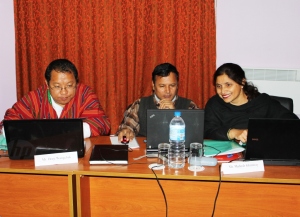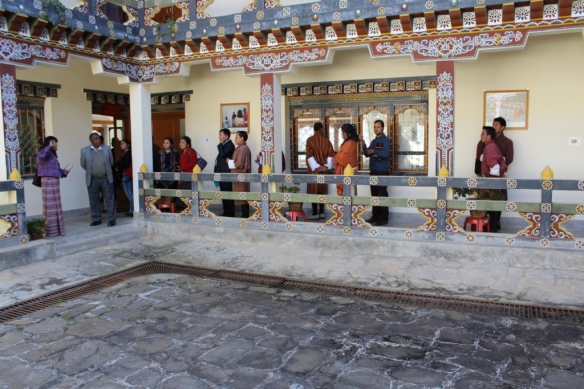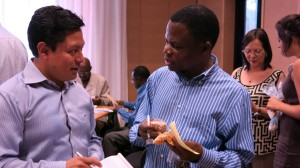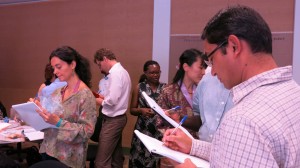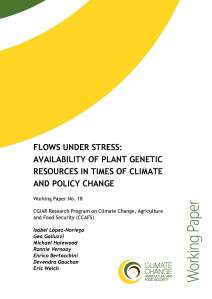Ouagadougou, 26 au 28 mai 2014
Par Koffi Emmanuel Kassin et Edmond Koffi
Du 26 au 28 mai 2014, nous avons pris part à atelier de formation sur les systèmes de semences robustes face aux changements climatiques organisé par l’INERA et Bioversity International à Ouagadougou (Burkina Faso). Cet atelier s’inscrit dans le cadre du renforcement de capacités nationales pour la mise en œuvre du Traité International sur les Ressources Phytogénétiques pour l’Alimentation et l’Agriculture (TIRPGAA). Ont pris part à cette formation une vingtaine de participants (chercheurs, enseignants chercheurs et étudiants) venus de la Côte d’Ivoire et du Burkina Faso.
Trois objectifs étaient assignés à cette rencontre. Il s’agissait d’une part, d’initier les participants aux outils du Système d’Information Géographique (SIG) pour la recherche de ressources phytogénétiques dans un contexte de changements climatiques, d’autre part de les familiariser à l’utilisation des outils SIG à travers des exercices pratiques à partir des données provenant des pays respectifs et enfin d’identifier les étapes prochaines pour l’application des outils dans des projets de recherche au Burkina Faso et en Côte d’Ivoire. La formation a été dispensée par Ronnie Vernooy de Bioversity International (Rome) et Gloria Otieno de Bioversity international Uganda avec l’appui de Sognigbe N’Danikou de Bioversity International Benin. Outre les chercheurs du CNRA, l’équipe de la Côte d’Ivoire comprenait deux enseignants chercheurs : Dr DIBI Pauline et Dr Koné Moussa de l’UFR Géographie Tropicale de l’Université Félix Houphouët Boigny.
Le programme de l’atelier d’une durée de trois jours s’est articulé autour de 4 points essentiels : 1. Introduction au cycle de recherche sur les systèmes de semences robustes face aux changements climatiques; 2. Acquisition, préparation des données d’accession et installation des logiciels; 3. Initiation aux outils DIVA-GIS et Analogue climatique; 4. Exercice de groupe.
DIVA-GIS et Analogue climatique
DIVA-GIS qui est un logiciel gratuit de cartographie sur internet. Initiation à DIVA-GIS a porté sur comment : élaborer des cartes de distribution à différentes échelles de la diversité biologique ; extraire les données climatiques des points de collecte des accessions ; prédire la présence d’espèces en fonction du climat actuel (1970-2000) et futur (2020-2050) en utilisant BIOCLIM. Avec l’outil « Analogue climatique » nous avons fait des simulations de changements climatiques, afin d’identifier les ressources adaptées à chaque type de scenario. En effet, cet outil est efficace pour : – prévoir l’agriculture de demain ; – déterminer des sites analogues actuels et futurs à partir de 19 indices bioclimatiques.
L’exercice de groupe a consisté à vérifier les connaissances acquises lors de la phase précédente. Ainsi, les participants ont été répartis en trois groupes dont deux pour le Burkina Faso et 1 pour la Cote d’Ivoire. Chaque équipe a eu à travailler sur les données nationales pour produire des cartes de répartition des accessions en fonction des zones climatiques et déterminer des sites analogues actuels et futurs. Les travaux des différentes équipes ont été présentés puis critiqués avant la clôture de l’atelier.
Apprentissages
Au cours de la formation, avons vu quelques aspects de l’utilisation des outils SIG. Toutefois, ils peuvent contribuer à mettre à jour les informations sur les sites de collecte des ressources phytogénétiques, réaliser un plan de la diversité des cultures au niveau global ou par pays, analyser et caractériser la diversité des ressources phytogénétiques ou faire une analyse complémentaire de la biodiversité pour la combinaison de traits et enfin identifier les sites correspondants potentiels pour la culture de variétés dans des conditions de stress biotiques et abiotiques.
Ces outils peuvent également permettre de faire une classification des collections basées sur le critère de l’adaptation climatique, fournir des informations climatiques (pluie mensuelle, température minimale et maximale) pour les sites de collecte individuels, élaborer des cartes climatiques de divers paramètres climatiques et leurs combinaisons. Ils peuvent également permettre de définir des lignes directrices pour développer des stratégies de collecte de nouvelles collections ainsi que pour la re-collecte du matériel génétique.
Ces outils apparaissent indispensables pour les chercheurs, particulièrement les sélectionneurs et les gestionnaires des ressources phytogénétiques. Une restitution à l’attention de ces sélectionneurs ainsi que des géographes et de tous ceux qui sont impliqués dans des travaux touchant au changement climatique s’avère nécessaire en vue d’une plus large diffusion de ces outils et d’une dissémination étendue des connaissances dans ce domaine.



